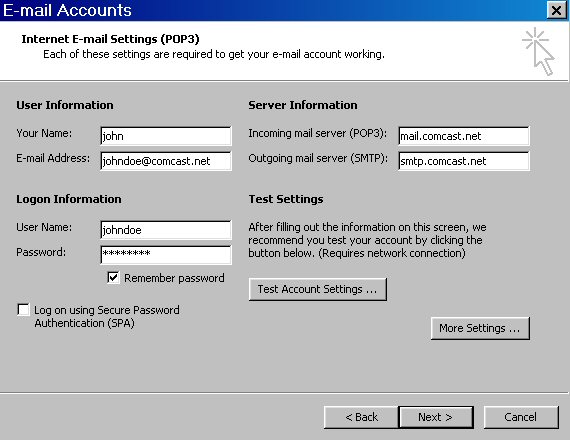

(You can separately set IPv6 DNS servers if needed, but IPv4 DNS servers can provide IPv6 addresses and vice versa.Ĭlick Update, which will temporarily make the network unavailable while the base station restarts with the new settings.ĪirPort Utility allows entering DNS server settings that are then used when network addresses are assigned to devices as they connect. In the DNS Servers fields, enter the server IP addresses.
#Comcast address book server password
(Enter the base station’s password if prompted.) Select your base station or the main base station in a network of more than one.Ĭlick the Edit button. If you’re using one or more Apple Wi-Fi base stations on your network and also use your only base station or your main one to hand out network assignments via DHCP, you can change what DNS values all connected devices use unless they’re overridden with local settings as with the instructions above. IOS only lets you change the DNS servers for each Wi-Fi network to which you connect. Tap the DNS field to erase and enter your own server values, separated by a comma. Tap the information i icon to the right of your active network. For a single home network, that’s not much of a burden, but it’s more of a problem when you roam, if you want to use alternate DNS. Instead, you have to change the DNS server addresses for each network you join. Unfortunately, Apple doesn’t offer global DNS settings in iOS. Choose settings > Make Service Active to turn on the other, if it’s not already. Select the service you’re not using and choose settings > Make Service Inactive to disable it. Now use the steps above to set the DNS values.įor clarity’s sake, select the original service, then the gear icon, then Rename Service to call it something distinct from Step 3. Name the duplicate something descriptive, like “Wi-Fi Google DNS.” If you want to be able to switch back and forth between your ISP’s DNS and a public DNS server, follow these steps:įrom the settings (gear) menu at the bottom of the adapters list, choose Duplicate Service. The new settings are immediately available. Then click + again to paste in the second.Ĭhange DNS settings in OS X through the Network preference pane by clicking Advanced with any adapter selected. Select your active adapter, such as Wi-Fi or ethernet.Ĭlick the + sign at the bottom and paste in the first DNS server. Open System Preferences and click Network.

In the vast majority of network configurations, an IP address and other network settings are provided from a DHCP (Dynamic Host Configuration Protocol) server on a local network via a router to all devices that need Internet access. (There are other public providers, but no reason I know of to shop around further.) It has the stylish numbers 8.8.8.8 and 8.8.4.4 for its DNS servers. Public DNS followed later, and is just DNS and nothing more. The company now has an array of free-with-registration and paid add-on services for malware, threat protection, and network usage analysis. OpenDNS made web browsing seem faster by having zippy servers. OpenDNS is the oldest of these, and it started at a time when ISP-run DNS servers were pokey as all get-out: it could take a second or even longer the first time your computer requested a given domain name to look up or resolve that name into an IP address. Switching to one requires a tiny bit of configuration, but no account or other arrangement with the service. So-called public DNS providers offer DNS lookups that anyone can use.


 0 kommentar(er)
0 kommentar(er)
